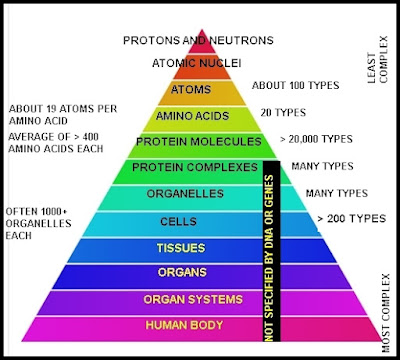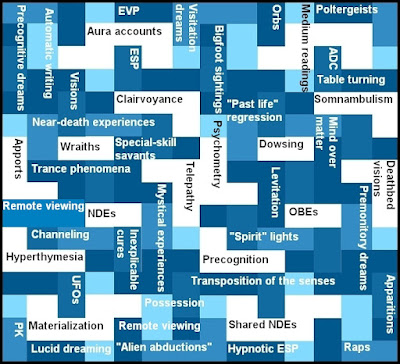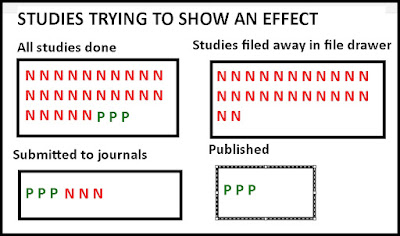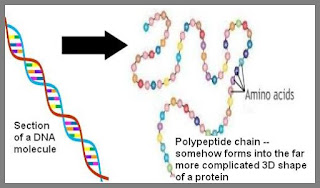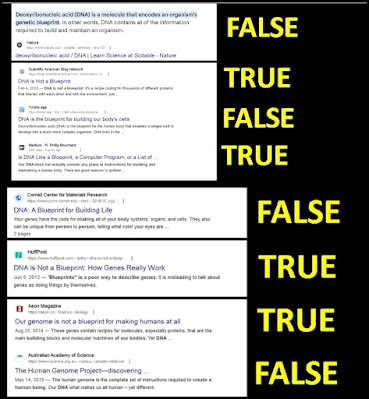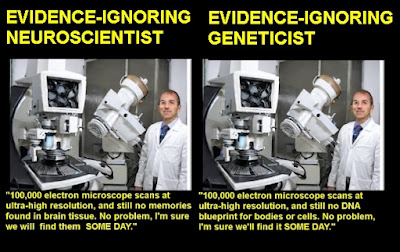Here is the latest in a series of videos I am making.
Thursday, February 29, 2024
Wednesday, February 28, 2024
A Biochemist's Promissory Note About Explaining Minds Sounds Very Lame
The site www.realclearscience.com calls itself the "Real Clear Science" site, but what it often gives us is not real clear science, but articles that are clearly ideology and propaganda pieces. Occasionally the propaganda includes PR pieces written to serve the vested interests of the pesticide industry. On January 6 the site had an article written to defend the pesticide industry and to attack whistleblowers who point out the hazards of pesticides. On the same day the site had a link to an article in the Irish Times entitled "Will science be able to explain consciousness?" with the title subtitle "There is every reason to believe that consciousness will eventually yield to scientific analysis just as the general nature of life yielded." The article is by emeritus biochemistry professor William Reville. The article is a very lame promissory note.
Reville starts out by claiming that "science now understands the basic molecular basis of life" and then stretches this into the claim that science understands the "general nature of life." He attempts to use this triumphal boast as a kind of springboard to suggest that solutions to the mystery of mind will be forthcoming. It's kind of like someone saying, "I was able to finish the one-kilometer race, so you can bet that I will be able to finish the marathon race."
But the claim that science understands "the general nature of life" is untrue. Scientists do not understand any such thing. In particular:
- Scientists lack any credible explanation of how cells in the human body are able to reproduce. Cells are fantastically organized units so complex they have been compared to factories. Scientists can describe various phases in cell reproduction, but do not understand how cell reproduction is able to occur. The reproduction of every eukaryotic cell is a marvel as hard to explain as a jet aircraft splitting up to become two working jet aircraft. One of the main reasons why scientists cannot explain how cells reproduce is that the DNA in the nucleus of cells does not contain any instructions for how to build a cell. Neither DNA nor its genes even specify how to make any of the organelles that are the main building components of cells. DNA merely specifies low-level chemical information such as which amino acids make up a protein. So we cannot at all explain the reproduction of cells by imagining that a cell reads from DNA some blueprint on how to make a cell.
- Scientists lack any credible explanation for the origin of any type of protein molecule. Living things require very many different types of protein molecules. In the human body there are more than 20,000 different types of protein molecules, each a different type of complex invention. Most types of protein molecules require hundreds of well-arranged amino acid parts, and that altogether requires thousands of very well-arranged atoms in an average protein molecule. How did so many types of protein molecules so organized originate? Scientists do not understand how this occurred. You do not have any credible explanation if you merely refer us to Darwin or natural selection or evolution. The problem is that the functional thresholds of functional protein molecules are very high, ruling out a Darwinian explanation for their origin. Darwin knew nothing about the complexity of protein molecules, and certainly did not explain their origin. For a good explanation of why Darwinism fails to explain the origin of protein molecules, read computer scientist David Gelernter's widely discussed book review entitled "Giving Up Darwin." I may note that in that book review, Gelernter misstated the average amino acid length of a protein molecule, listing it as merely 250. For the type of cells humans have (eukaryotic cells), the average length of a protein molecule is about 472 amino acids, meaning the probability of evolution producing a successful protein molecule (estimated by Gelernter as basically zero) is very, very many orders of magnitude smaller than Gelernter suggests. As four Harvard scientists stated in a paper, "A wide variety of protein structures exist in nature, however the evolutionary origins of this panoply of proteins remain unknown."
- Scientists lack any credible explanation for how protein molecules get the three dimensional shapes needed for their function. DNA merely specifies which amino acids make up particular protein molecules, and does not specify the three-dimensional shapes that such molecules must have to function properly. How do protein molecules form into such shapes? That is the long-standing problem called the protein folding problem, and it has never been solved. Don't be fooled by false claims that some AlphaFold2 software solved the protein problem. Such software merely made progress on a different problem, called the protein folding prediction problem. The quotes below tell us the truth on this matter: (1) "In real time how the chaperones fold the newly synthesized polypeptide sequences into a particular three-dimensional shape within a fraction of second is still a mystery for biologists as well as mathematicians." -- Arun Upadhyay, "Structure of proteins: Evolution with unsolved mysteries," 2019. (2) "The problem of protein folding is one of the most important problems of molecular biology. A central problem (the so called Levinthal's paradox) is that the protein is first synthesized as a linear molecule that must reach its native conformation in a short time (on the order of seconds or less). The protein can only perform its functions in this (often single) conformation. The problem, however, is that the number of possible conformational states is exponentially large for a long protein molecule. Despite almost 30 years of attempts to resolve this paradox, a solution has not yet been found." -- Two scientists, "On a generalized Levinthal's paradox," 2018.
- Scientists lack any credible explanation of how protein complexes are able to form. This is the problem of why it is that protein molecules so often form into very organized protein complexes, teams of protein molecules needed for the protein molecules to be functional. Such complexes are often so organized they are called "molecular machines." We cannot explain their formation merely be referring to DNA. Neither DNA nor its genes specify which protein molecules belong to particular protein complexes, nor do they specify how the intricate arrangement should occur. Here are some relevant quotes: (1) "The majority of cellular proteins function as subunits in larger protein complexes. However, very little is known about how protein complexes form in vivo." --Duncan and Mata, "Widespread Cotranslational Formation of Protein Complexes," 2011. (2) "While the occurrence of multiprotein assemblies is ubiquitous, the understanding of pathways that dictate the formation of quaternary structure remains enigmatic." -- Two scientists (link). (3) "A general theoretical framework to understand protein complex formation and usage is still lacking." -- Two scientists, 2019 (link). (4) "Protein assemblies are at the basis of numerous biological machines by performing actions that none of the individual proteins would be able to do. There are thousands, perhaps millions of different types and states of proteins in a living organism, and the number of possible interactions between them is enormous...The strong synergy within the protein complex makes it irreducible to an incremental process. They are rather to be acknowledged as fine-tuned initial conditions of the constituting protein sequences. These structures are biological examples of nano-engineering that surpass anything human engineers have created. Such systems pose a serious challenge to a Darwinian account of evolution, since irreducibly complex systems have no direct series of selectable intermediates, and in addition, as we saw in Section 4.1, each module (protein) is of low probability by itself." -- Steinar Thorvaldsen and Ola Hössjerm, "Using statistical methods to model the fine-tuning of molecular machines and systems," Journal of Theoretical Biology.
- Scientists lack any credible explanation of how any adult human body is able to appear. The physical structure of an adult human being is a state of organization many millions of times more complex than a mere fertilized speck-sized egg cell. (A human egg cell is about a tenth of a millimeter in length, but a human body occupies a volume of about 75 million cubic millimeters.) So you don't explain the physical origin of an adult human being by merely referring to the fertilization of an egg cell during or after sexual intercourse. We cannot explain the origin of an adult human body by merely using words such as "development" or "growth." Trying to explain the origin of an adult human body by merely mentioning a starting cell and mentioning "growth" or "development" is as vacuous as trying to explain the mysterious appearance of a building by saying that it appeared through "origination" or "construction." If we were to find some mysterious huge building on Mars, we would hardly be explaining it by merely saying that it arose from "origination" or by saying that it appeared through "construction." When a person tries to explain the origin of a human body by merely mentioning "growth" or "development" or "morphogenesis," he is giving as empty an explanation as someone who tells you he knows how World War II started, because he knows that it was caused by "historical events." The claim that you can explain the origin of a human body by imagining a reading of a DNA blueprint for making a human body is a lie long told by biologists and chemists. As many scientists have confessed, no such blueprint or recipe or program for making a human body exists in DNA. As discussed here, not only does DNA not specify how to make a human, DNA does not even specify how to make any organ or appendage or cell of a human. There are more than 200 types of cells in human beings, each an incredibly organized thing (cells are so complex they are sometimes compared to factories or cities). DNA does not specify how to make any of these hundreds of types of cells. Cells are built from smaller structural units called organelles. DNA does not even specify how to make such low-level organelles.
Scientists have made no real progress in understanding the origin of life. No experiments realistically simulating early Earth conditions have ever been able to produce life from non-life. No experiments realistically simulating early Earth conditions have ever been able to produce the building blocks of one-celled life (organelles) from non-life. No experiments realistically simulating early Earth conditions have ever been able to produce the building blocks of the building blocks of one-celled life (functional protein molecules) from non-life. No experiments realistically simulating early Earth conditions have ever even been able to produce the building blocks of the building blocks of the building blocks of one-celled life (biologically relevant amino acids) from non-life. It was widely claimed that the Miller-Urey experiment produced the building blocks of the building blocks of the building blocks of one-celled life (biologically relevant amino acids) from non-life. But such claims were false.The Miller-Urey experiment never realistically simulated early Earth conditions, for reasons explained here.
HUMANS CONSIST OF HUMAN BODIES AND HUMAN MINDS. | Human minds have displayed a vast number of capabilities, many of which mainstream scientists fail to properly study. |
HUMAN BODIES MAINLY CONSIST OF ORGAN SYSTEMS AND A SKELETAL SYSTEM. | The human skeletal system contains 206 bones. |
ORGAN SYSTEMS CONSIST OF ORGANS AND SUPPORTING STRUCTURES. | Examples of organ systems include the circulatory system (consisting of much more than just the heart), and the nervous system consisting of much more than just the brain. |
ORGANS CONSIST OF TISSUES. | |
TISSUES CONSIST OF VERY COMPLEX AND VASTLY ORGANIZED CELLS | There are more than 200 types of cells in the human body, each a different type of system of enormous organization. Cells are so complex they have been compared to factories with many types of manufacturing devices. |
CELLS TYPICALLY CONSIST OF VERY COMPLEX MEMBRANES AND THOUSANDS OR MILLIONS OF ORGANELLES. |
|
ORGANELLES CONSIST OF VERY MANY PROTEIN MOLECULES AND PROTEIN MOLECULE COMPLEXES. | There are some 100,000 different types of protein molecules in the human body, each a different type of complex invention. Protein molecule complexes are groups of different types of protein molecules that work together as team members to achieve a function that cannot be achieved by only one of the proteins in the complex. Very many protein complexes have so many parts working together dynamically that such complexes are now being called "molecular machines." |
PROTEIN MOLECULES CONSIST OF HUNDREDS OR THOUSANDS OF WELL-ARRANGED AMINO ACIDS, EXISTING IN A FOLDED THREE-DIMENSIONAL SHAPE. | Small changes in the sequences of amino acids in a protein are typically sufficient to ruin the usefulness of the protein molecule, preventing it from folding in the right way to achieve its function. See "The Fragility of Fine-Tuned Protein Molecules" section of the post here for quotes stating this. |
AMINO ACIDS CONSIST OF ABOUT 10 ATOMS ARRANGED IN SOME SPECIFIC WAY. | Some amino acids have 20 atoms. Given 10+ atoms in amino acids, and an average of about 470 amino acids per human protein molecule, a human protein molecule contains an average of about 5000+ very well-arranged atoms. Amino acids in living things are almost all left-handed, although amino acids forming naturally will with 50% likelihood be right-handed. |
ATOMS CONSIST OF MULTIPLE PROTONS, NEUTRONS AND ELECTRONS. | A carbon atom has 6 protons, 6 neutrons, and 6 electrons. |
Sunday, February 25, 2024
Wednesday, February 21, 2024
Universities Continue to Boast About Pitifully Weak Neuroscience Results
The authors then confess to us about the miserably bad statistical power of their results. The "rule of thumb" used in experimental studies is that to reach a statistical power considered "good," you need to get what is called a statistical power of at least 80%. But the authors confess their results have a statistical power of only 10%.
Friday, February 16, 2024
Wednesday, February 14, 2024
DNA Is Not a Blueprint, So "All Bets Are Off" About Body Origins and Mind Origins
Ever since the discovery of DNA and the genetic code in the middle of the twentieth century, many scientists have been making an untrue claim about DNA: the claim that DNA is some kind of blueprint or program or recipe for making a human body.
There are various ways in which this false idea is stated, all equally false:
- Many described DNA or the genome as a blueprint for an organism.
- Many said DNA or the genome is a recipe for making an organism.
- Many said DNA or the genome is a program for building an organism, making an analogy to a computer program.
- Many claimed that DNA or genomes specify the anatomy of an organism.
- Many claimed that genotypes (the DNA in organisms) specify phenotypes (the observable characteristics of an organism).
- Many claimed that genotypes (the DNA in organisms) "map" phenotypes (the observable characteristics of an organism) or "map to" phenotypes.
- Many claimed that DNA contains "all the instructions needed to make an organism."
- Many claimed that there is a "genetic architecture" for an organism's body or some fraction of that body.
- Using a little equation, many claimed that a "genotype plus the environment equals the phenotype," a formulation as false as the preceding statements, since we know of nothing in the environment that would cause phenotypes to arise from genotypes that do not specify such phenotypes.
Judging from the facts, we must conclude that while DNA uses a code of symbolic representations (the genetic code), DNA is not a blueprint for making a human, is not a recipe for making a human, and is not a program or algorithm for making a human. The facts indicate that DNA is not anything close to a complete specification of an organism, but that DNA is instead something much simpler, mainly just a kind of database (or a collection of ingredient lists) used in making particular parts of an organism.
| Type of information | Can it be specified in DNA? |
| Linear amino acid sequence of a protein molecule | Yes |
| Three-dimensional shape of a protein molecule | No |
| Exact location where a protein is located in body | No |
| Layout of a cell organelle | No |
| Layout of a cell | No |
| Layout of a tissue type | No |
| Layout of an organ | No |
| Layout of an organ system | No |
| Layout of a full body plan | No |
| Structure progression from simplest tiniest form to fully grown form | No |
| Dynamic behavior inside an organism during a particular month or year | No |
| MINIATURE LANGUAGES | |||
| NAME | LIST OF WORDS IN LANGUAGE | WHAT CAN BE SPECIFIED BY LANGUAGE | WHAT CANNOT BE SPECIFIED BY LANGUAGE |
| Sandwich Language | Bread, Turkey, Ham, Cheese, Lettuce, Tomato, Onion, Bacon | Various types of sandwiches | Anything that is not a sandwich |
| Exercise Language | Jump, Crouch, Stretch, Punch, Lift, Bend, Squat, Spin | Various types of exercises | Anything that is not an exercise |
| DNA Language | Alanine, Asparagine, Aspartic acid, Arginine, Cysteine, Glutamine, Glycine, Glutamic acid, Histidine, Isoleucine, Lysine,Leucine, Phenylalanine, Methionine, Serine, Proline, Tryptophan,Threonine, Tyrosine, Valine | Polypeptide sequences – a linear one-dimensional sequence of amino acids | Anything that is not a polypeptide sequence, including the 3D shape of a protein, the shape of any body part, the structure of any organism, or a behavior or instinct. |
- On page 26 of the recent book The Developing Genome, Professor David S. Moore states, "The common belief that there are things inside of us that constitute a set of instructions for building bodies and minds -- things that are analogous to 'blueprints' or 'recipes' -- is undoubtedly false."
- Biologist Rupert Sheldrake says this "DNA only codes for the materials from which the body is constructed: the enzymes, the structural proteins, and so forth," and "There is no evidence that it also codes for the plan, the form, the morphology of the body."
- Describing conclusions of biologist Brian Goodwin, the New York Times says, "While genes may help produce the proteins that make the skeleton or the glue, they do not determine the shape and form of an embryo or an organism."
- Professor Massimo Pigliucci (mainstream author of numerous scientific papers on evolution) has stated that "old-fashioned metaphors like genetic blueprint and genetic programme are not only woefully inadequate but positively misleading."
- Neuroscientist Romain Brette states, "The genome does not encode much except for amino acids."
- In a 2016 scientific paper, three scientists state the following: "It is now clear that the genome does not directly program the organism; the computer program metaphor has misled us...The genome does not function as a master plan or computer program for controlling the organism; the genome is the organism's servant, not its master.
- In the book Mind in Life by Evan Thompson (published by the Belknap Press of Harvard University Press) we read the following on page 180: "The plain truth is that DNA is not a program for building organisms, as several authors have shown in detail (Keller 2000, Lewontin 1993, Moss 2003)."
- Developmental biologist C/H. Waddington stated, "The DNA is not a program or sequentially accessed control over the behavior of the cell."
- Scientists Walker and Davies state this in a scientific paper: "DNA is not a blueprint for an organism; no information is actively processed by DNA alone...DNA is a passive repository for transcription of stored data into RNA, some (but by no means all) of which goes on to be translated into proteins."
- Geneticist Adam Rutherford states that "DNA is not a blueprint," a statement also made by biochemistry professor Keith Fox.
- "The genome is not a blueprint," says Kevin Mitchell, a geneticist and neuroscientist at Trinity College Dublin, noting "it doesn't encode some specific outcome."
- "DNA cannot be seen as the 'blueprint' for life," says Antony Jose, associate professor of cell biology and molecular genetics at the University of Maryland, who says, "It is at best an overlapping and potentially scrambled list of ingredients that is used differently by different cells at different times."
- Sergio Pistoi (a science writer with a PhD in molecular biology) tells us, "DNA is not a blueprint," and tells us, "We do not inherit specific instructions on how to build a cell or an organ."
- Michael Levin (director of a large biology research lab) states that "genomes are not a blueprint for anatomy," and after referring to a "deep puzzle" of how biological forms arise, he gives this example: "Scientists really don’t know what determines the intricate shape and structure of the flatworm’s head."
- Ian Stevenson M.D. stated "Genes alone - which provide instructions for the production of amino acids and proteins -- cannot explain how the proteins produced by their instructions come to have the shape they develop and, ultimately, determine the form of the organisms where they are," and noted that "biologists who have drawn attention to this important gap in our knowledge of form have not been a grouping of mediocrities (Denton, 1986; Goldschmidt, 1952; B. C. Goodwin, 1985, 1988, 1989, 1994; Gottlieb, 1992; Grasse, 1973; E. S. Russell...Sheldrake, 1981; Tauber and Sarkar, 1992; Thompson, 1917/1942)."
- Biologist B.C. Goodwin stated this in 1989: "Since genes make molecules, genetics...does not tell us how the molecules are organized into the dynamic, organized process that is the living organism."
- An article in the journal Nature states this: "The manner in which bodies and tissues take form remains 'one of the most important, and still poorly understood, questions of our time', says developmental biologist Amy Shyer, who studies morphogenesis at the Rockefeller University in New York City."
- Timothy Saunders, a developmental biologist at the National University of Singapore says, "Fundamentally, we have a poor understanding of how any internal organ forms.”
- On the web site of the well-known biologist Denis Noble, we read that "the whole idea that genes contain the recipe or the program of life is absurd, according to Noble," and that we should understand DNA "not so much as a recipe or a program, but rather as a database that is used by the tissues and organs in order to make the proteins which they need."
- A paper by Stuart A. Newman (a professor of cell biology and anatomy) discussing at length the work of scientists trying to evoke "self-organization" as an explanation for morphogenesis states that "public lectures by principals of the field contain confidently asserted, but similarly oversimplified or misleading treatments," and says that "these analogies...give the false impression that there has been more progress in understanding embryonic development than there truly has been." Referring to scientists moving from one bunk explanation of morphogenesis to another bunk explanation, the paper concludes by stating, "It would be unfortunate if we find ourselves having emerged from a period of misconceived genetic program metaphors only to land in a brave new world captivated by equally misguided ones about self-organization."
- Referring to claims there is a program for building organisms in DNA, biochemist F. M. Harold stated "reflection on the findings with morphologically aberrant mutants suggests that the metaphor of a genetic program is misleading." Referring to self-organization (a vague phrase sometimes used to try to explain morphogenesis), he says, "self-organization remains nearly as mysterious as it was a century ago, a subject in search of a paradigm."
- Writing in the leading journal Cell, biologists Marc Kirschner, John Gerhart and Tim Mitchison stated, "The genotype, however deeply we analyze it, cannot be predictive of the actual phenotype, but can only provide knowledge of the universe of possible phenotypes." That's equivalent to saying that DNA does not specify visible biological structures, but merely limits what structures an organism can have (just as a building parts list merely limits what structures can be made from the set of parts).
- At the Stack Exchange expert answers site, someone posted a question asking which parts of a genome specify how to make a cell (he wanted to write a program that would sketch out a cell based on DNA inputs). An unidentified expert stated that it is "not correct" that DNA is a blueprint that describes an organism, and that "DNA is not a blueprint because DNA does not have instructions for how to build a cell." No one contradicted this expert's claim, even though the site allows any of its experts to reply.
- A paper co-authored by a chemistry professor (Jesper Hoffmeyer) tells us this: "Ontogenetic 'information,' whether about the structure of the organism or about its behavior, does not exist as such in the genes or in the environment, but is constructed in a given developmental context, as critically emphasized, for example, by Lewotin (1982) and Oyama (1985)."
- Biologist Steven Rose has stated, "DNA is not a blueprint, and the four dimensions of life (three of space, one of time) cannot be read off from its one-dimensional strand."
- Jonathan Latham has a master's degree in Crop Genetics and a PhD in virology. In his essay “Genetics Is Giving Way to a New Science of Life,” a long essay well worth a read, Latham exposes many of the myths about DNA. Referring to "the mythologizing of DNA," he says that "DNA is not a master controller," and asks, "How is it that, if organisms are the principal objects of biological study, and the standard explanation of their origin and operation is so scientifically weak that it has to award DNA imaginary superpowers of 'expression'” and 'control' to paper over the cracks, have scientists nevertheless clung to it?"
- An interesting 2006 paper by six medical authorities and scientists tells us that "biochemistry cannot provide the spatial information needed to explain morphogenesis," that "supracellular morphogenesis is mysterious," and that "nobody seems to understand the origin of biological and cellular order," contrary to claims that such order arises from a reading of a specification in DNA.
- Keith Baverstock (with a PhD in chemical kinetics) has stated "genes are like the merchants that provide the necessary materials to build a house: they are neither the architect, nor the builder but, without them, the house cannot be built," and that "genes are neither the formal cause (the blueprint), nor the efficient cause (the builder) of the cell, nor of the organism."
- Evolutionary biologist Richard Lewontin stated, "DNA is not self-reproducing; second, it makes nothing; and third, organisms are not determined by it." Noting that "the more accurate description of the role of DNA is that it bears information that is read by the cell machinery," Lewontin lamented the "evangelical enthusiasm" of those who "fetishized DNA" and misspoke so that "DNA as information bearer is transmogrified into DNA as blueprint, as plan, as master plan, as master molecule." In another work he stated "the information in DNA sequences is insufficient to specify even a folded protein, not to speak of an entire organism." This was correct: DNA does not even specify the 3D shapes of proteins, but merely their sequence of amino acids.
- In 2022 developmental biologist Claudio D. Stern first noted, "All cells in an organism have the same genetic information yet they generate often huge complexity as they diversify in the appropriate locations at the correct time and generate form and pattern as well as an array of identities, dynamic behaviours and functions." In his next sentence he stated, "The key quest is to find the 'computer program' that contains the instructions to build an organism, and the mechanisms responsible for its evolution over longer periods." Since this was written long after the Human Genome Project had been completed, he thereby suggested that no such instruction program had yet been discovered in the genome (DNA).
- As soon as DNA and the genetic code were discovered, around the middle of the twentieth century very many scientists started to tell a wholly unjustified lie that DNA was a blueprint or recipe or program for making the human body. Nothing had been discovered that justified any such claim. The code used by DNA (the genetic code) is something capable of expressing only low-level chemical information, not any high-level structural information.
- The lie that DNA is a body blueprint continued to be told by many scientists throughout the rest of the 20th century. During the last decade of that century, the Human Genome Project was busy making a complete list of all the genes in DNA.
- When the Human Genome Project completed in 2001, very many scientists continued to make the false claim that DNA is a blueprint for making a human, even though no evidence supporting such a claim had been found by this gigantic effort analyzing the contents of DNA.
- Despite all these claims, by now many scientists have confessed that neither DNA (the genome) nor its genes are any such thing as a blueprint or recipe or program for making a human body, and in February 2024 the leading science journal Nature had an article entitled "It's time to admit that genes are not the blueprint of life," contrary to its numerous previous claims that genes are such a blueprint.
- "I was all ready to marry Willy because I thought he was someone who would be devoted to me for the rest of my life. But I just learned he's been having a sex affair with his co-worker, so all bets are off."
- "I was going to invest many thousands in New Shiny Tech, Inc. But I just learned that their profit and loss statement is bogus, so now all bets are off."
- "I was set to buy that house on Maple Street, but the inspection report shows the foundation is all rotting, and that the pipes are all leaking inside the walls. So now all bets are off."
